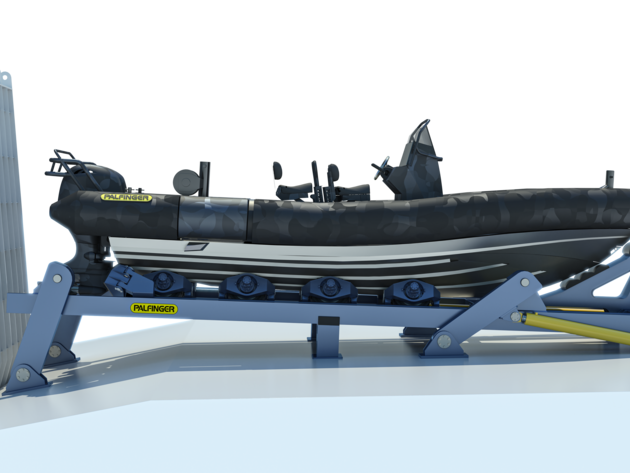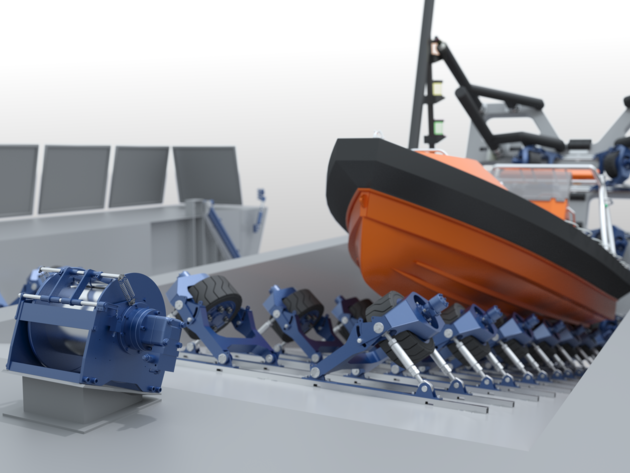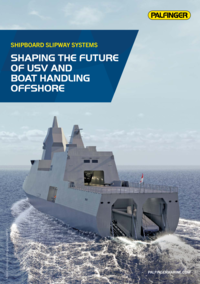
- Home
- Deck Equipment
- Slipway and Stern Entry Systems
- Model PSWS-T-D
Model PSWS-T-D
SWL: Up to 6 tons
Wheel-drive system: Hydraulic
Single wheel-drive units: Manually adjustable wheel angle to adapt to different hull shapes
Boat length: 6 - 12 meter
Slipway angle: Up to 12o slope angle
Slipway access/entrance: Via submerged wheel-drive units on slipway cradle
Boat guiding system: Boat guide and deflector plates at slipway entrance
Slipway frame dimensions: Designed to purpose and vessel interface
Slipway frame suspension: Load bearing tilting arms
Slipway cradle movement: Hydraulic cylinder driven tilt and drive mechanism
Max. frame outreach: Designed to vessels waterline
Power supply for frame and cradle: Via energy chain
- Remote control from daughter craft
- Various remote control options on vessel side
- Power and control system redundancy
- Emergency launch and recovery by accumulator and UPS
- Multi-axis adjustment of wheel-drive units
- Higher slope angle and/or SWL (if possible/feasible)
Slipway and stern entry systems with single wheel-drive units
PALFINGER’s hydraulically powered, semi-automatic Slipway System consists of several single wheel-drive units in parallel rows. The tilt, height, and distance between the wheels can be manually adjusted to conform to a range of daughter craft hulls.
A daughter craft can engage the slipways at a range of speeds up to seven knots higher than the speed of the mother vessel. When a boat enters the slipway, the overrunning clutches allow free rotation of the wheels in the recovery direction until the boat speed and wheel-drive speeds match.
At that point, the hydraulically powered wheel-drive units will take over under single-operator control and dock the daughter craft safely inside the slipway. End stoppers automatically set the craft in parking and stowage positions and engage the fail-safe brakes on the wheel-drives.
MAX. SEA STATE FOR SLIPWAY OPERATIONS
Test and operational use of this slipway system have been performed in Sea States 3 with mother vessel steaming ahead with low speed.
Safe operations at higher Sea States may be possible but is highly dependent on:
- Stern entry arrangement
- Mother vessel heading and speed
- Mother vessel responsiveness (RAO Profile)
- Waves and wind pattern
- Boat driver’s skills
SINGLE WHEEL-DRIVE UNITS
Wheel-drive unit configuration: 1 wheel on each wheel-drive unit
Wheel angle and transverse spacing: Manually adjustable
Brakes: 1 for each wheel
Hydraulic motors: 1 for each wheel
Over-running clutches: 1 for each wheel
Number of single wheel-drive units: Depending on length of slipway
Wheel diameter: Ø 434 mm (Foam filled)
Max. freewheel speed, inlet: 0-240 m/min (0-7 knots)
Drive assist speed, in and out: 0-25 m/min (0-0.8 knots)
Max. slipway slope angle: Up to 12°
Max. payload for slipway: Up to 12 tons
Max load, each wheel: 2 tons
Weight (each wheel-drive unit): Approximately 420 kg





